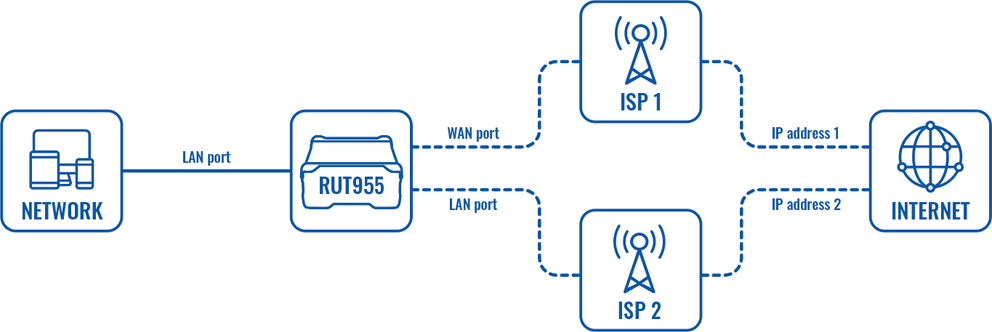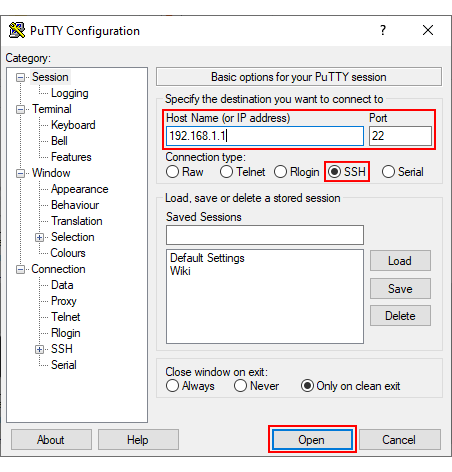LAN as WAN: Difference between revisions
No edit summary |
(Running version RUT9XX_R_00.06.09. Without these option the new WAN doesn't show in the WAN area. These entries taken from other default interfaces.) |
||
| (16 intermediate revisions by one other user not shown) | |||
| Line 1: | Line 1: | ||
<!--<font size="-1"><i>Last edit | <!--<font size="-1"><i>Last edit was on <u>{{REVISIONMONTH}}/{{REVISIONDAY}}/{{REVISIONYEAR}}</u></i></font>--> | ||
==Introduction== | ==Introduction== | ||
| Line 53: | Line 53: | ||
After clicking '''Open''' you will need to enter router credentials. | After clicking '''Open''' you will need to enter router credentials. | ||
<li>Login as: '''root'''</li> | <li>Login as: '''root'''</li> | ||
<li>Password: routers admin password (by default admin01)</li> | <li>Password: routers admin password (by default admin01)</li> | ||
[[File:Networking_rutxxx_configuration_examples_use_lan_as_wan_9_v1.png]]<br><br> | [[File:Networking_rutxxx_configuration_examples_use_lan_as_wan_9_v1.png]]<br><br> | ||
| Line 74: | Line 72: | ||
<li><i>option ifname 'eth0.1'</i></li> | <li><i>option ifname 'eth0.1'</i></li> | ||
<li><i>option backup '1'</i></li> | <li><i>option backup '1'</i></li> | ||
<li><i>option metric '10'</i><br>[[File:Networking_rutxxx_configuration_examples_use_lan_as_wan_4_v1.png]]</li> | <li><i>option metric '10'</i></li> | ||
<li>option enabled '1' | |||
</li> | |||
<li>option disabled '0'<br> | |||
</li> | |||
<li>[[File:Networking_rutxxx_configuration_examples_use_lan_as_wan_4_v1.png]] | |||
</li> | |||
<li>Press the <b>Escape (E<small>SC</small>)</b> button on your keyboard; type <b><i>:wq</i></b> and press <b>Enter</b> to close the editor and save the changes.</li> | <li>Press the <b>Escape (E<small>SC</small>)</b> button on your keyboard; type <b><i>:wq</i></b> and press <b>Enter</b> to close the editor and save the changes.</li> | ||
<li>Restart the network service on the router in order to apply the changes by executing this command:<br><pre>/etc/init.d/network restart</pre></li> | <li>Restart the network service on the router in order to apply the changes by executing this command:<br><pre>/etc/init.d/network restart</pre></li> | ||
| Line 118: | Line 122: | ||
</ul> | </ul> | ||
[[Category:Control]] [[Category:Config | [[Category:-Network Control]] [[Category:RUT955 Config Examples]] [[Category:RUT950 Config Examples]] [[Category:RUT900 Config Examples]] [[Category:RUT240 Config Examples]] [[Category:RUT230 Config Examples]] | ||
Latest revision as of 15:07, 6 June 2022
Network > -Network Control > LAN as WANIntroduction
This article provides a guide on how to configure the LAN ports as WAN. It can be useful as wired ISP redundant connection or even to change the port for physical damage or a custom mounting.
Configuration overview and prerequisites
Before we begin, let's overview the configuration that we are attempting to achieve and the prerequisites that make it possible.
Prerequisites:
- One RUTxxx series router (excluding RUT850).
- At least two wired Internet connections.
- An end device for test the configuration.
Configuration scheme:
WebUI Router configuration
Connect to the router’s WebUI navigate to Network → VLAN → LAN Network and create a new interface by entering name and clicking Add New.
After you clicked Add New new configuration window will pop-up, there you leave as default and press Save.
After saving settings, you will be redirected back to Network → VLAN → VLAN Networks, now you need to open VLAN Network tab in the same window and you will need to:
- Select VLAN mode: Port based
- Current LAN interface:
- Enable wireless access
- Select your current LAN interface.
- Turn off LAN port 3 (which will be used as WAN port)
- Press Save.
Note: Make sure that you are not connected to that LAN port which you going to disable.
- New LAN_WAN interface:
- Click Add and a new row will appear.
- Turn off LAN ports 1-2 and leave only LAN port 3 on.
- Select your newly created interface in the LAN section and click Save.
CLI/SSH Router configuration
For the next part you will be configuring router via SSH. For this you need to use the command line interface (CLI) or a SSH software if you’re using Windows or iOS. In this example software putty will be used. Open putty enter routers LAN IP address and press Open.
After clicking Open you will need to enter router credentials.
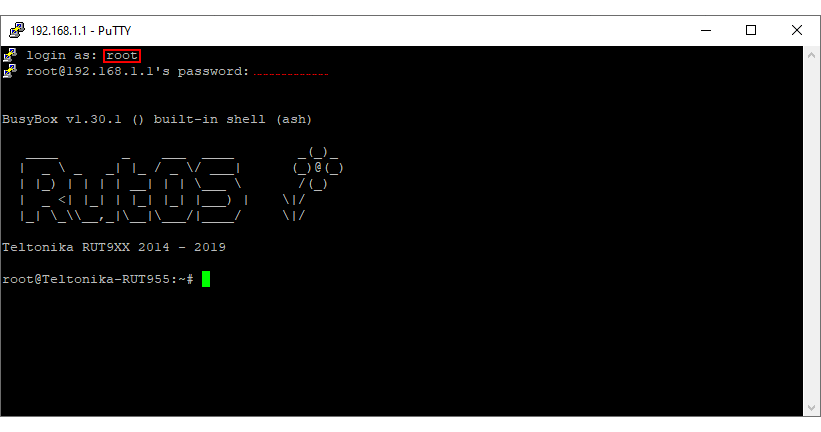
Now when you are connected you will need to make changes to network settings, this will be achieved via SSH command: vi, which allows you to edit settings in the router. Enter following command in SSH:
vi /etc/config/network
Then press the 'I' button on your keyboard to enable editing.
Using DHCP
Using the arrow keys on your keyboard, navigate and find config interface 'lan_wan' erase the current configuration and write these options:
- option proto 'dhcp'
- option ifname 'eth0.1'
- option backup '1'
- option metric '10'
- option enabled '1'
- option disabled '0'
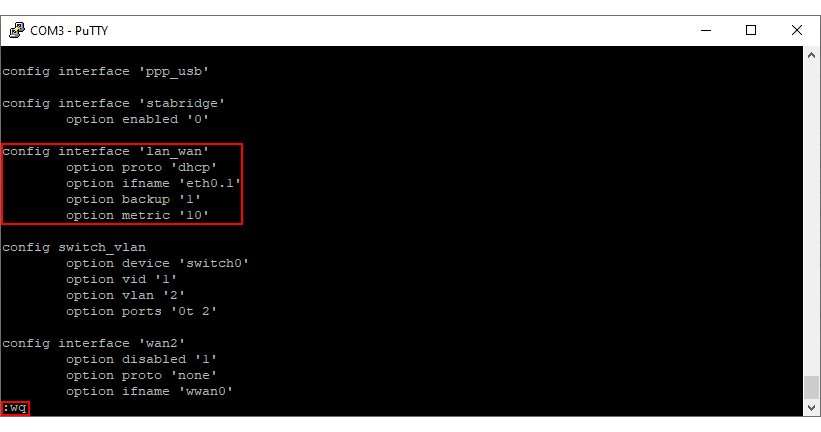
- Press the Escape (ESC) button on your keyboard; type :wq and press Enter to close the editor and save the changes.
- Restart the network service on the router in order to apply the changes by executing this command:
/etc/init.d/network restart
- You can exit PuTTY after this return to the WebUI; navigate to the Network → Firewall → General Settings page.
- Scroll down to the Zone Forwarding section, find source zone: lan_wan.
- Change Default forwarding action from reject to accept, tick the Masquerading checkbox and save the changes.

Using Static IP
If you're using DHCP, jump to the next section of this guide
Use the arrow keys to navigate the file and find the config interface 'lan_wan' section. Add these four options to the configuration:
- option gateway '192.168.10.1'
- option dns '8.8.8.8'
- option backup '1'
- option metric '10'
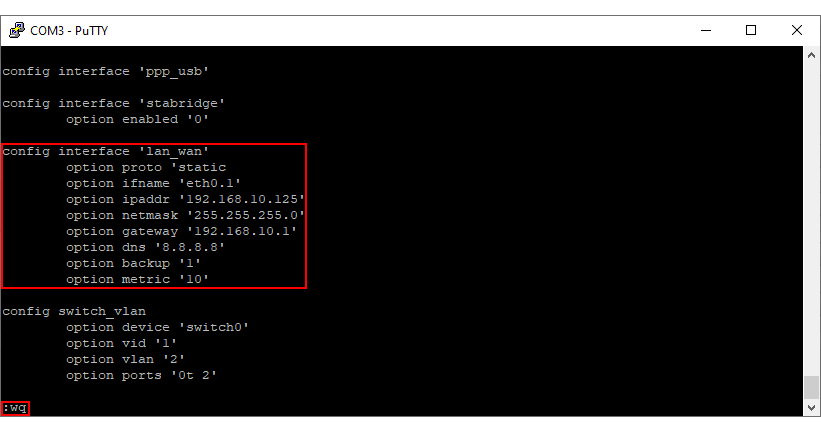
- Press the Escape (ESC) button on your keyboard; type :wq and press Enter to close the editor and save the changes.
- Restart the network service on the router in order to apply the changes by executing this command:
/etc/init.d/network restart
- You can exit PuTTY after this return to the WebUI; navigate to the Network → Firewall → General Settings page.
- Scroll down to the Zone Forwarding section, find source zone: lan_wan.
- Change Default forwarding action from reject to accept, tick the Masquerading checkbox and save the changes.

Testing the configuration
If everything went well, your device should now have two wired WAN connections. To test this go to the Network → WAN page and check if the new interface is enabled and if it has an IP address.
- Set the Wired (WAN) interface as the main WAN connection.
- Set the new interface as WAN failover and save the changes.
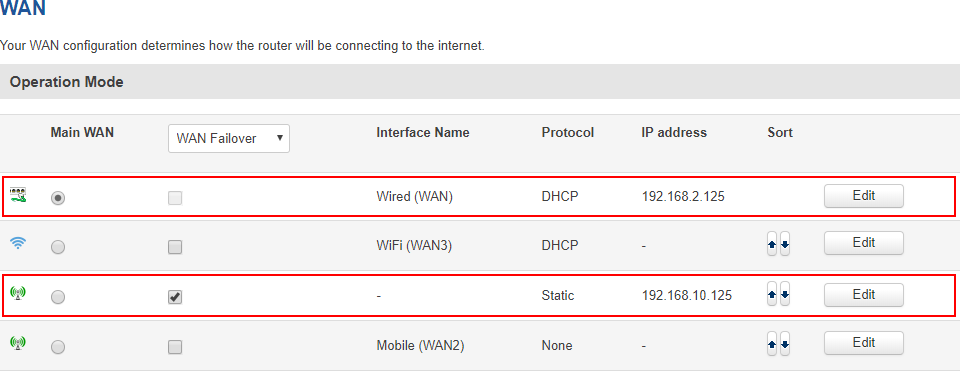
- Go to [www.whatsmyip.com] and check your public IP address.

- Then unplug the main WAN cable and check again. If the interface failed over correctly, the website should a different IP address than before.

- Plug the main WAN cable back in and wait a bit. Refresh the website; the IP should have change back to the one shown in the first place.

